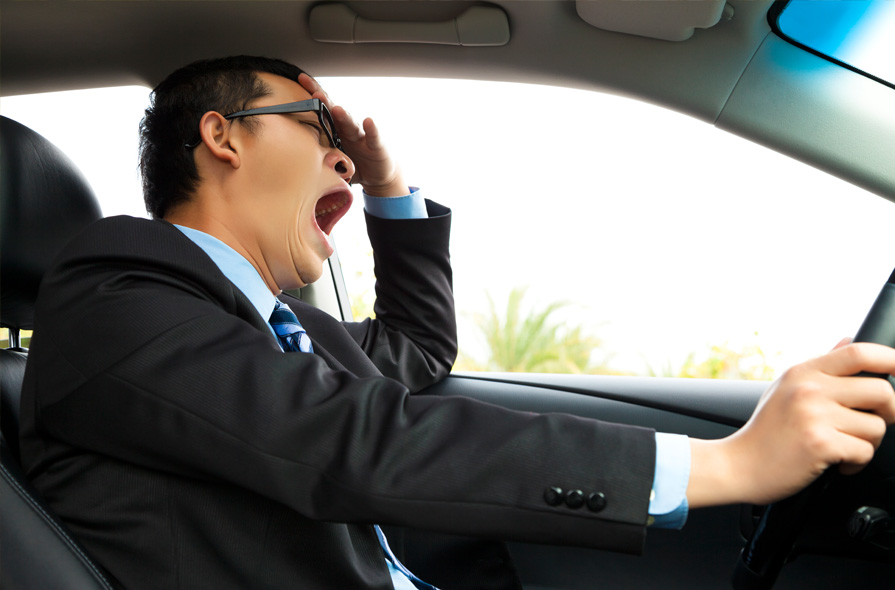Driving Drunk vs Driving Tired

For years, there have been public relations campaigns, billboards, commercials and support groups that have kept you from drinking and driving. As important and effective as those drinking and driving campaigns have been, there’s something else that you might be doing every day that could be even worse than driving drunk – drowsy driving. Driving while sleepy is an all-too-common and very dangerous problem. More than half of U.S. drivers admit that they’ve driven while drowsy, and more than one-third admit to falling asleep at the wheel! If you watch for the warning signs of driver fatigue and follow tips to stay alert, you’ll decrease your chances of becoming a drowsy driver. Your choice to get enough sleep and avoid sleepy driving can save your life and the lives of others.
Drowsy Driving Stats
If you think you can handle driving when you’re drowsy, think again. Lack of sleep can have the same hazardous effects as drugs and alcohol. Drowsiness can significantly slow your reaction time, decrease awareness, and impair your judgment. And just like drugs or alcohol, drowsiness can be fatal when driving.
Drowsy driving is the cause of at least 100,000 auto crashes each year, according to the National Highway Traffic Safety Administration. Despite the obvious dangers of drowsy driving, many of us still do it. Surveys conducted by the National Safety Council estimate the prevalence of drowsy driving among U.S. drivers as follows:
- More than one-third (37 percent) of drivers report having nodded off or fallen asleep while driving in the past year.
- Among those who report nodding off while driving, thirteen percent say they’ve done so at least one or more times per month.
- Four percent of drivers admit they have had an accident or near-accident due to drowsiness in the past year.
How to Know When You’re Too Tired to Drive
Some people cannot tell that they are close to falling asleep. Others feel like they can fight off the desire to close their eyes by opening a window or turning the radio volume up. Unfortunately, the urge to sleep can come on suddenly, and both groups are putting themselves and others in danger. There are several warning signs to consider when you’re driving and feeling tired.
- Difficulty focusing, frequent blinking, or heavy eyelids.
- Wandering or disconnected thoughts.
- Trouble remembering driving the last few miles; missing exits or traffic signs.
- Yawning repeatedly or rubbing your eyes.
- Trouble keeping your head up
- Drifting from your lane, tailgating, or hitting a shoulder or rumble strip
- Abnormal speed
- Feeling restless, irritable, or impatient
- Back tension, burning eyes, shallow breathing, or inattentiveness
If you’re feeling any of these while driving, please safely pull over and rest.
Who is at Risk?
Since we all need adequate sleep, any driver can experience a decrease in alertness when they have not had enough rest. That said, research points to young males, night-shift workers, commercial drivers (especially long-haul drivers), and anyone who drives a high number of miles every day as being at increased risk for a fall-asleep crash. People with untreated sleep disorders such as insomnia or sleep apnea are also at elevated risk for accidents stemming from drowsy driving. Sedating medications like antidepressants, cold tablets, and antihistamines can also put you at risk, so be sure to check drug labels or talk to your doctor before getting behind the wheel when you’re taking medication.
How to Avoid Drowsy Driving
There are several easy to implement ways to avoid falling asleep at the wheel.
- Get a good night’s sleep before you hit the road. You’ll want to be alert for the drive, so be sure to get adequate sleep (seven to nine hours) the night before you go.
- Don’t be too rushed to arrive at your destination. Many drivers try to maximize the holiday weekend by driving at night or without stopping for breaks. It’s better to allow the time to drive alert and arrive alive.
- Use the buddy system. Just as you should not swim alone, avoid driving alone for long distances. A buddy who remains awake for the journey can take a turn behind the wheel and help identify the warning signs of fatigue.
- Take a break every 100 miles or 2 hours. Do something to refresh yourself like getting a snack, switching drivers, or going for a run.
- Take a nap—find a safe place to take a 15 to 20-minute nap, if you think you might fall asleep. Be cautious about excessive drowsiness after waking up.
- Avoid alcohol and medications that cause drowsiness as a side-effect.
- Avoid driving at times when you would normally be asleep.
- Consume caffeine. The equivalent of two cups of coffee can increase alertness for several hours so try to balance caffeine and sleep.
Laws differ from state to state, but there is an increasing focus on treating drowsy driving as a criminal offense in cases where someone is injured or killed. Don’t let the dangerous combination of driving and sleepiness get you in trouble. Stay rested and stay safe.